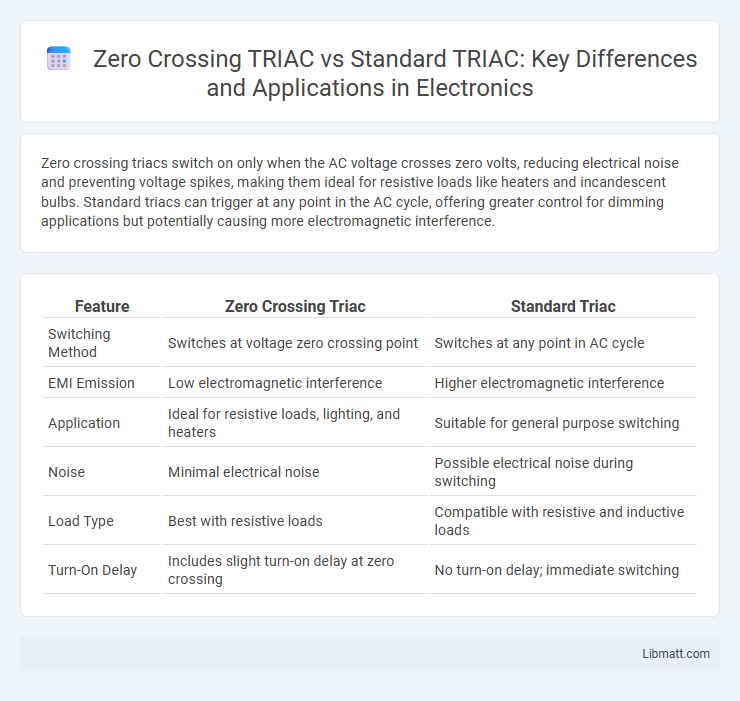Zero crossing triacs switch on only when the AC voltage crosses zero volts, reducing electrical noise and preventing voltage spikes, making them ideal for resistive loads like heaters and incandescent bulbs. Standard triacs can trigger at any point in the AC cycle, offering greater control for dimming applications but potentially causing more electromagnetic interference.
Table of Comparison
| Feature | Zero Crossing Triac | Standard Triac |
|---|---|---|
| Switching Method | Switches at voltage zero crossing point | Switches at any point in AC cycle |
| EMI Emission | Low electromagnetic interference | Higher electromagnetic interference |
| Application | Ideal for resistive loads, lighting, and heaters | Suitable for general purpose switching |
| Noise | Minimal electrical noise | Possible electrical noise during switching |
| Load Type | Best with resistive loads | Compatible with resistive and inductive loads |
| Turn-On Delay | Includes slight turn-on delay at zero crossing | No turn-on delay; immediate switching |
Introduction to Triacs: Zero Crossing vs Standard
Triacs are semiconductors used for AC power control, with two main types: zero crossing and standard Triacs. Zero crossing Triacs switch on precisely when the AC waveform crosses zero voltage, reducing electrical noise and minimizing electromagnetic interference in your circuits. Standard Triacs can trigger at any point in the AC cycle, offering more control flexibility but potentially generating more noise and voltage spikes.
Understanding Zero Crossing Triacs
Zero crossing triacs are designed to switch on when the AC voltage waveform crosses zero volts, minimizing electrical noise and reducing electromagnetic interference compared to standard triacs. This zero-crossing feature provides smoother control of resistive loads, making them ideal for lighting dimmers and motor speed controllers. Unlike standard triacs that can trigger at any point in the waveform, zero crossing triacs enhance performance stability and extend the lifespan of connected devices.
How Standard Triacs Operate
Standard Triacs operate by triggering conduction at any point in the AC waveform once the gate receives a triggering signal, allowing current flow between the main terminals regardless of the voltage zero crossing. This flexibility enables control of power delivery but can cause electromagnetic interference (EMI) due to sudden switching and abrupt changes in current. Your choice of a Standard Triac ensures compatibility with various loads but may require additional filtering to mitigate noise and improve circuit stability.
Key Differences Between Zero Crossing and Standard Triacs
Zero Crossing Triacs switch on only at the zero voltage point of the AC cycle, minimizing electrical noise and reducing stress on connected devices, whereas Standard Triacs can switch on at any point, allowing for more precise phase angle control and dimming capabilities. You should consider Zero Crossing Triacs for applications requiring smooth operation and reduced electromagnetic interference, while Standard Triacs are better suited for fine-tuned power control in lighting and motor speed systems. The fundamental difference lies in the timing of gate activation, impacting efficiency, noise levels, and control precision.
Applications of Zero Crossing Triacs
Zero crossing triacs are widely used in applications that require minimizing electrical noise and reducing voltage spikes, such as light dimmers, motor speed controls, and AC power switching devices in home appliances and industrial equipment. These triacs switch on only when the AC voltage crosses zero, protecting sensitive components and ensuring smoother operation in circuits handling resistive and inductive loads. Your projects benefit from improved performance and longevity when using zero crossing triacs in environments demanding precise and safe AC power control.
Typical Uses for Standard Triacs
Standard triacs are commonly used in applications requiring phase control and full-wave switching, such as light dimmers, motor speed controllers, and heater regulators. They excel in circuits where precise timing of switching is less critical or where switching noise can be tolerated. Your choice of a standard triac is ideal when cost-effectiveness and simple construction outweigh the need for reduced electromagnetic interference.
Advantages of Zero Crossing Triacs
Zero Crossing Triacs offer significant advantages over standard Triacs by reducing electromagnetic interference (EMI) and minimizing inrush current through switching at the AC waveform's zero voltage point. This precise timing enhances the longevity of connected loads and improves overall system reliability by preventing voltage spikes and current surges. Their superior performance in dimming, motor control, and resistive load applications makes them ideal for energy-efficient and noise-sensitive environments.
Limitations of Standard Triacs
Standard Triacs often suffer from high electromagnetic interference due to non-zero crossing switching, causing noise in sensitive electronic circuits. Their inability to switch precisely at the zero voltage crossing point results in increased power dissipation and reduced efficiency. These limitations make Standard Triacs less suitable for applications requiring smooth and low-noise operation, such as in LED dimming and audio equipment.
Choosing the Right Triac for Your Application
Zero Crossing Triacs reduce electrical noise and extend device lifespan by switching on only when the AC voltage crosses zero, making them ideal for dimmers and light control applications. Standard Triacs switch on at any point in the AC cycle, offering faster response times suitable for motor control and phase angle triggering. Selecting the appropriate Triac depends on balancing the need for noise reduction versus switching speed, considering the specific load and control requirements of your application.
Future Trends in Triac Technology
Future trends in Triac technology emphasize improving energy efficiency and reducing electromagnetic interference with advanced zero crossing detection techniques. Zero Crossing Triacs enhance performance by switching at voltage zero points, minimizing voltage spikes and noise, which is crucial for smart home and IoT applications. Your adoption of these innovations ensures more reliable, low-noise control in modern lighting and motor control systems.
Zero Crossing Triac vs Standard Triac Infographic

 libmatt.com
libmatt.com